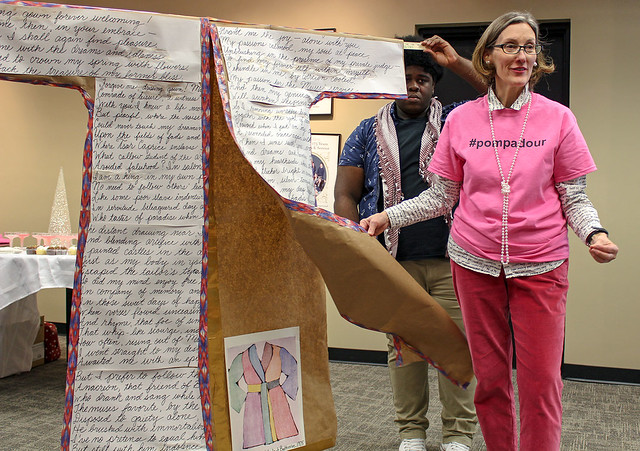Novel Fashion
Comparative Literature Readings Inspire OWU Students to Create Paper Clothing

The classroom met the catwalk for students of professor Stephanie Merkel’s “Reason and Romanticism.”
For their final projects, students in the honors comparative literature class designed life-size paper clothing based off the “novels of circulation,” or novels with a non-human protagonist such as clothing or coins, they read during fall semester.
Originally inspired by Merkel’s academic studies of the intersection of literature and fashion, the class also aligned with Department of Comparative Literature’s “Text-Tiles” pop-up exhibit in Sturges Hall.
The course dealt with the “satire and sentimentalism” of the long 18th century. Clothing played a significant role in works discussing materialism, commerce, and social performance. In class, students practiced studying garments in 18th century art as texts, exploring how what people wore told the world about who they were.
Students also traveled to The Frick Pittsburgh to see an exhibit by Isabelle de Borchgrave, an artist creating trompe l’oeil paper fashion sculptures. Their trip was funded by the OWU Honors Program and Department of Comparative Literature. The exhibit inspired Merkel to create a paper fashion show as her class’s final project.
“There were three components of the project,” says Merkel, Ph.D. “The actual, technological garment found in the Encyclopèdie; the verbal sign, found in literature; and the visual sign, found in painting.
“I wanted the students to really get into the subject-object relationship with Bill Brown’s ‘Thing Theory,’ a theory of how mere objects become ‘things,’ or acquire meaning,” Merkel says.
At their catwalk event, Merkel discussed the historic significance of each item of clothing. Students displayed their works to a playlist of songs inspired by their creation’s historic significance.
Delanie Baker ’19 showed off her paper corset to Queen’s “I Want to Break Free,” symbolizing the restrictive nature of the garment.
Penell Paglialunga ’19, a comparative literature major, was Baker’s partner in creating the corset.
“For the pleasure of men, women, some starting at infancy, confined themselves in these metal-and-bone-lined corsets. It increased their risk of pneumonia, tuberculosis, fainting, liver cancer, and pregnancy complication,” Paglialunga said.
Paglialunga also designed a tricorn hat, a popular style for both military men and common folk in the 18th century. While designing the hat was a challenge, Paglialunga says she liked having a creative outlet along with her research.
Merkel viewed the project as a way for students not just to expand their personal knowledge of reason and romanticism, but their ability to work together with peers to share knowledge with a larger demographic.
“I hope the students, and our audience, gained a broader concept of ‘text,’” Merkel says. “Not just written texts, but garments, things as texts.”
